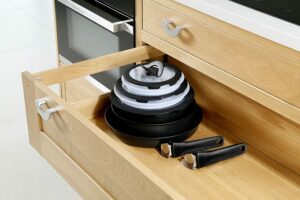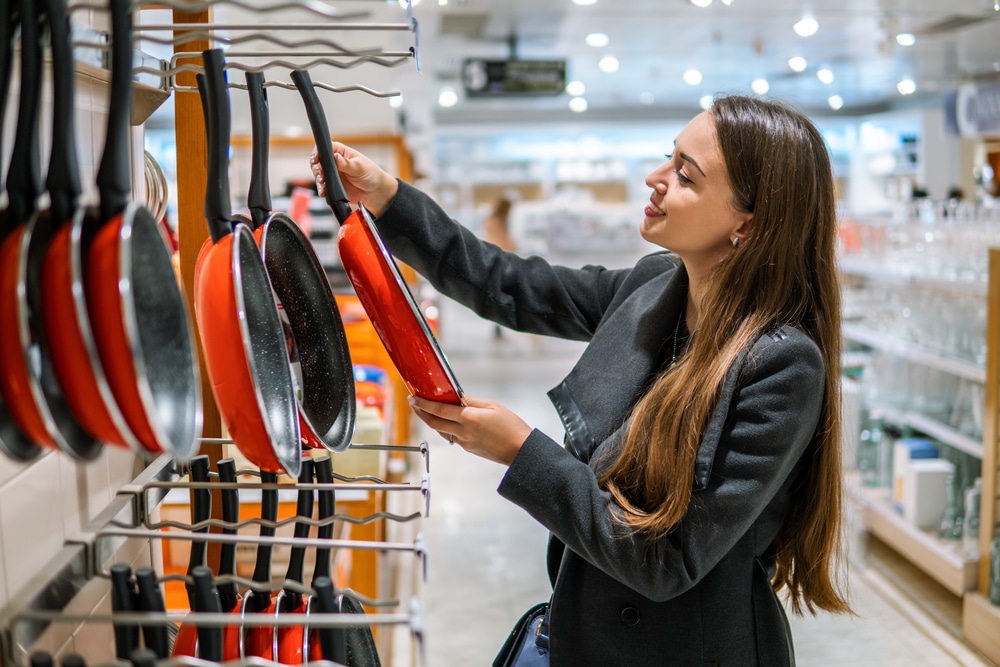Last Updated on January 10, 2023
Whether you are just starting to stock a new kitchen or want to add to your current collection, it is not uncommon to find yourself asking – what size saucepans do I need? This can be especially true once you start looking at different size pans and pots and realise how many types there truly are. That’s why we created this handy guide to the most common types of pans so you can start to sort out the difference. We also discuss how you can determine which pans will best suit your needs and the ones we think are the most useful for a basic cookware set.
What Saucepans are Considered Kitchen Essentials?
When determining which saucepans will be essential in your kitchen setup, you will need to start by asking yourself the following questions:
1. What types of food do you usually make?
Although most cookware is fairly versatile, ultimately, pots, pans, and baking dishes are designed for specific purposes. The dishes you cook and enjoy eating will determine which pieces of cookware get the most use in your kitchen.
View this post on Instagram
2. How many people do you cook for on a regular basis?
This may seem a bit obvious, but if you cook for a large family – you will be best served by larger-sized cookware. Adversely, if you live alone or with one other person, small to medium-sized cookware may be more than enough to get the job done.
3. What type of hob will you be cooking on?
If you cook on a gas or electric hob, you can skip this question. However, if you use an induction hob, this can be important. Induction hobs use magnetic energy to create heat conductivity. Hence, your cookware must be compatible, or in other words – magnetic. Aluminium pans, copper cookware, and glass cookware are not compatible with induction hobs.
4. Do you have enough space to store your pots and pans?
 The last question you need to ask yourself is whether or not you have enough cupboard space or room in your kitchen to store the pots, pans, and cookware you are considering. If you don’t have the storage space, it most likely isn’t essential.
The last question you need to ask yourself is whether or not you have enough cupboard space or room in your kitchen to store the pots, pans, and cookware you are considering. If you don’t have the storage space, it most likely isn’t essential.
Keep these questions in mind as you read through the next section. After reading through the guide explaining the different types of pots and pans, we will reference these questions to truly determine which saucepans you need for your kitchen.
A Guide to Saucepan Sizes and Shapes
Now let’s explore some of the most common types of cookware found on the market today. After all, to determine which saucepans you need, you have to know what your options are, right?
Frying Pans and Skillets
A frying pan or skillet is easily recognized by its shallow cooking space, long handle, and short sloped sides. Many but not all, frying pans and skillets come with a lid as well. The sloped sides of a frying pan allow you to flip and toss ingredients using only one hand and no utensils.
A skillet or fry pan provides even heat distribution and is excellent for stir-frying all types of meats and vegetables.
These pans and skillets come in a wide array of shapes, sizes, and materials. Some are non-stick and others are made with stainless steel or cast iron. In general, they range between 8 and 15 inches in diameter.
Saute Pans
Saute pans are similar to a frying pan or skillet except that they have taller, vertical sides to help keep your food in the pan. Saute pans have a large flat base, a long handle, and almost always come with a lid. Many sauté pans also have a small loop-style handle opposite the long handle for an added grip that can prove handy with heavier recipes.
View this post on Instagram
Saute pans are highly versatile and can be used to cook all types of foods. You can use them to fry, saute, sear meats, or simmer sauces.
A sauté pan comes in a variety of shapes, sizes, and materials. For the most part, they range between 8 and 15 inches in size, too. A smaller 8-inch size sauté pan is good for one person, maybe two -depending on your recipe.
Saucepans
The term saucepan is often the generic word for pans, but they actually refer to a specific type of pan. Saucepans have a round base and vertical sides similar to a saute pan but significantly taller. They come with a lid, feature a long handle, and often have another smaller loop-style handle for added support when transferring your food.
Saucepans are also highly versatile and can be used to cook any type of sauce including pasta sauce. It can cook rice and boil smaller amounts of water, too.
Most saucepans have a 1.5 to 5-quart capacity. A medium-sized 3-quart saucepan can be found in almost any kitchen.
Stockpots
Stockpots are a larger version of a saucepan and are, in fact, the largest style of pot for use on your hob. They have a round flat base and extra tall vertical sides. Stockpots feature two loop-style handles on either side and come with a lid.
Stockpots should be used to accomplish larger cooking recipes. They are great for boiling water and are often used as pasta pot or for making soup or chilli.
Stockpot sizes pick up right where saucepan sizes leave off. Their capacity starts at 6 quarts and goes up to 20 or more. If you plan on cooking an entire box of pasta at one time, we recommend choosing an 8-quart stockpot or larger.
Dutch Ovens
A dutch oven is made with dense, heavy materials like enamelled cast iron, ceramic, and stoneware. Most dutch ovens are oval or round in shape and have tall sides, two loop-style handles, and a lid similar to a stockpot. Dutch ovens retain a maximum amount of heat and keep foods tender and juicy during the cooking process – thanks to the heavier materials and secure lid.
A dutch oven can be used on a hob or in the oven. They are excellent for slow-cook recipes like casseroles, roasts, stews, and braising meats.
Most Dutch ovens range between 5 and 8 quarts in capacity but you can find a wide variation in sizes in this type of cookware as well.
Additional Speciality Pans
For a more specialised home kitchen, there are also some other speciality pans that could significantly upgrade your cooking skills by helping you cook specific dishes more effectively. However, since we don’t think anyone “needs” them, we won’t go into great detail.
Honourable Mentions:
- Griddle: good for pancakes or larger quantities of food as it provides sufficient cooking space that spans between heating elements on your hob.
- Wok: good for anyone who is an enthusiastic fan of Asian foods and any type of stir-fry. Woks are often made with a carbon steel material that heats up rapidly and don’t require a lot of added fluid or oil like a saucepan or some grill pans often do.
- Grill pan: good for anything you want grill marks on like steak, burgers, chicken, or paninis.
- Brasier: good for small dutch oven tasks and recipes that transfer from the hob to the oven.
The Top Saucepans for Multi-Purpose Use: Basic Kitchen Tools
 Some people prefer to buy a complete matching set of cookware. But if you don’t cook a lot, or just getting your kitchen started, or don’t cook a wide variety of foods – then a set could leave you with extra, unnecessary pots and pans.
Some people prefer to buy a complete matching set of cookware. But if you don’t cook a lot, or just getting your kitchen started, or don’t cook a wide variety of foods – then a set could leave you with extra, unnecessary pots and pans.
A set of cookware also limits the material to one or maybe two kinds if you’re lucky. However, if you are looking for high-quality cookware with tons of versatility when it comes to your choice of recipes, you will want to make sure your starter kitchen set contains a few different types of material.
5 Best Pans and Sizes for a Starter Kitchen:
Medium-Sized Cast Iron Skillet
A 10 or 12-inch cast-iron skillet is an excellent piece of cookware that has high heat resistance, retains heat super well, and easily transfers between the oven and hob. A cast-iron skillet can even withstand the heat of a campfire. Cast iron pans can be used for frying, searing, pancakes, and much more.
Medium or Large-Sized Non-Stick Skillet or Frying Pan
A 12-inch non-stick pan is ideal for cooking eggs and other fragile ingredients. Some find non-stick pans are easier to cook with, in general, but they can be more fragile in the long run.
Large Stainless Steel Saute Pan
Stainless steel pans will work in the same ways as a frying pan or skillet but are able to do more – thanks to their taller, flat sides. This is the pan you will use to make risotto, and large meat or vegetable dishes. Just remember to monitor stainless steel pans closely for best results. Otherwise, it could burn on the bottom or stick to the pan. We think a 10 or 12-inch is the most multi-functional size.
Medium-Sized Saucepan
A 3-quart saucepan is a kitchen staple that is good for reheating saucy foods and soups, making gravy or other sauces, and cooking rice.
Medium or Large-Sized Stockpot
A 10 to 16-quart stockpot will allow you to cook larger portions and will serve you well when it comes to boiling water, making pasta, and soup.
Conclusion
We hope our guide to the most common types of saucepans and sizes helped you answer your initial question, what size saucepans do I need? By now, you know exactly what makes each type unique, and how each one is useful in a kitchen. Do you think our top 5 best types of pans will be enough for your home kitchen? Whatever you decide, at least you know you’ll be making an informed decision.
Of course, this is just a guide and you may find that certain pots work better for you than others. So if you ever cook in a friend’s kitchen, think about how handy each pot is and if you could do with one of your own. You can always add to your collection as you start experimenting.
Emily is a woman of many talents. She has a B.A. in English and enjoys writing. Emily loves accessorising her home with quality products that not only serve a purpose but also enhance the overall convenience and tranquillity of her living space; there’s nothing like coming home to your own personal sanctuary after a long day! She loves anything that can make life easier or more comfortable—from dishware to furniture to lighting fixtures.

